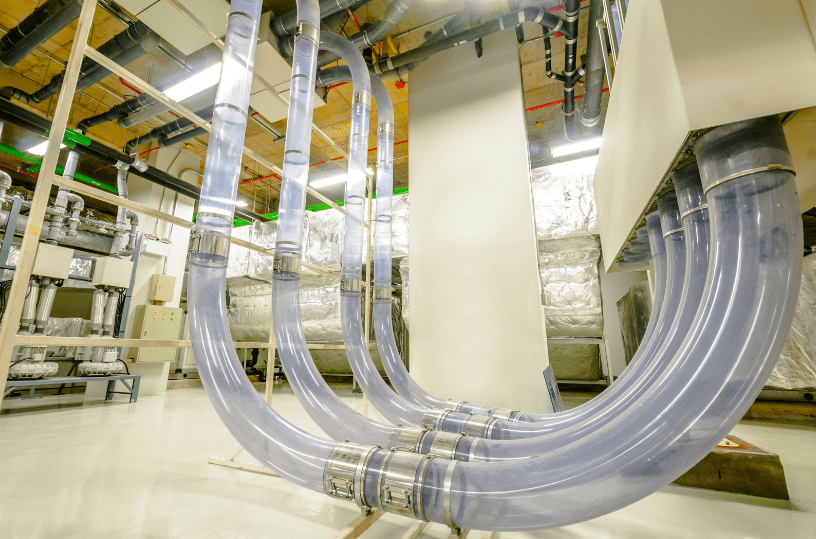Pneumatic, pressurised gas systems play a pivotal role in numerous medical and healthcare applications, due to their hygiene rating, speed, and reliability, as well as their capacity to deliver high power output within a compact design. These applications include medical compressed air devices, surgical tools, ventilators, and oxygen generators, as well as infrastructure applications such as climate control and filtration systems.
In this article, we’ll look at how pneumatic systems are transforming the healthcare manufacturing landscape, and how these versatile fluid power systems can be deployed within your applications.![]()
1. Pneumatic Tube Systems
Vacuum-based pneumatic tube systems provide a secure, hygienic, and swift means of transporting sensitive materials, such as lab samples, patient notes, and medications, around a healthcare facility or hospital. These systems are now used in over 100 NHS hospitals across the UK, with the first installed as far back as 1990.
2. Medical Air
Medical-grade compressed air applications are universally used in healthcare facilities to support respiratory patients, and pneumatic systems play a key role in providing these services, including air compressor systems for pure breathing and surgical air, vacuum, and oxygen. To maintain the quality of compressed air, pneumatic systems are equipped with filters that remove contaminants from the air, safeguarding medical professionals and patients from exposure to harmful airborne pathogens, including Covid-19.
3. Air Quality And Filtration Devices
High Efficiency Particulate Air (HEPA) filtration devices, often powered by pneumatic technology, help purify the air in hospital wards and healthcare facilities, removing airborne contaminants and helping sustain a safe and healthy indoor environment for patients and staff. The pneumatic technology that powers these filtration devices is less susceptible to contamination and also operates at a higher efficiency level than many alternative fluid power solutions. Pneumatic systems are also often quieter in operation than their hydraulic equivalents, making them better suited for inpatient hospital wards and treatment environments.
4. Climate Control Systems
Climate control is another area of medical technology in which pneumatic systems are proving invaluable to fluid power designers, forming an integral part of the systems that maintain optimal temperature and humidity levels in hospitals. From air curtains that maintain pressure differentials to climate control systems that automatically adjust temperature and humidity to meet pre-set operating parameters, pneumatic fluid power systems have revolutionised climate control infrastructure in a growing number of hospitals and medical facilities.
5. Medical Rehabilitation Care
Pneumatic systems also play a vital role in rehabilitation procedures used to treat musculoskeletal disorders, including compression machines, blood circulation machines, electrotherapy pad stimulators, and other devices. The use of pneumatic systems helps enhance the efficiency and effectiveness of medical rehabilitation, helping patients recover from devastating injuries faster and more completely.
6. Surgical Devices
Pneumatic-powered surgical devices are increasingly common in operating theatres across the UK, with compressed gas being the primary power source for a wide range of surgical devices, including surgical staplers, saws, and drills. Pneumatic surgical devices reduce tissue damage and enable greater scope for minimal invasive surgery, while also giving the surgeon higher levels of precision and control over the surgical procedure. At the same time, pneumatically powered medical instruments help reduce operator fatigue levels during high frequency usage or long operations, reducing the risk of error and making the process more efficient.
Why Are Fluid Power Engineers Turning To Pneumatic Systems For Medical And Healthcare Applications?
So, why the prevalence of pneumatic systems within modern medical and healthcare applications? One of the main reasons is the unprecedented precision and accuracy delivered by pneumatic systems, which makes them ideal for use in sensitive and intricate medical applications with extremely tight tolerances. For example, some of the most exciting applications of pneumatic systems in modern medical devices are in surgical procedures such as laparoscopy, bronchoscopy, and an endoscopy.
The superior reliability of pneumatic systems also makes them a go to for medical designers, minimising the risk of unscheduled downtime and maintenance requirements – which can be extremely detrimental or even life-threatening in an emergency care environment. Pneumatic-powered applications are cost-effective and energy-efficient, giving NHS hospitals and clinics an affordable and sustainable way of delivering state-of-the-art medical care without compromising on performance.
Find Out More
To find out more about the use of pneumatic systems within the medical and healthcare manufacturing sector, please call today on 01353 721704.


